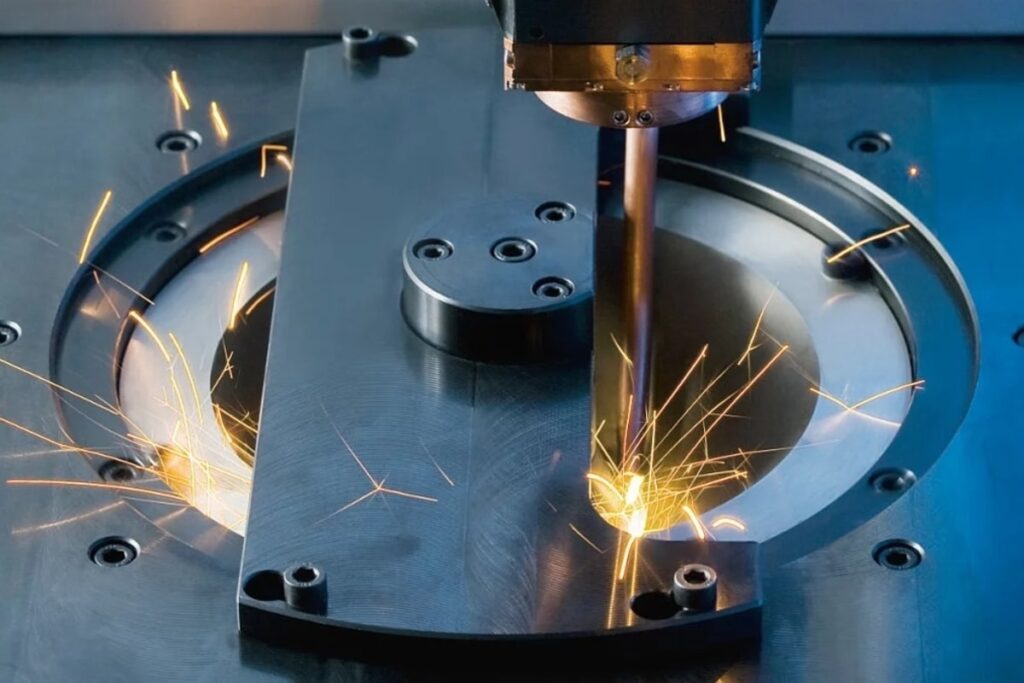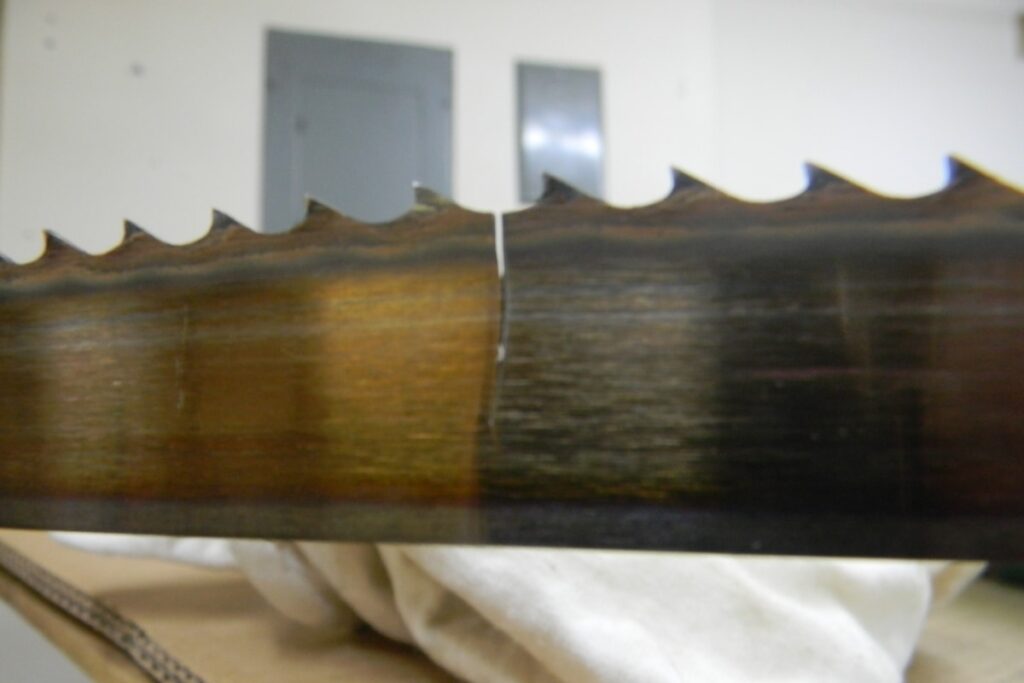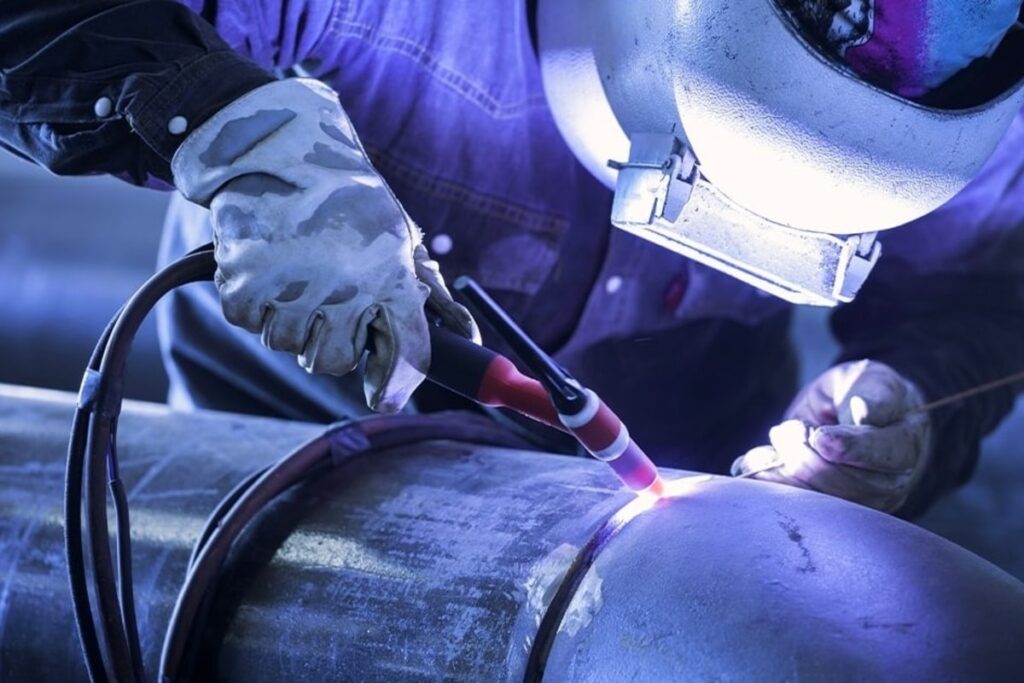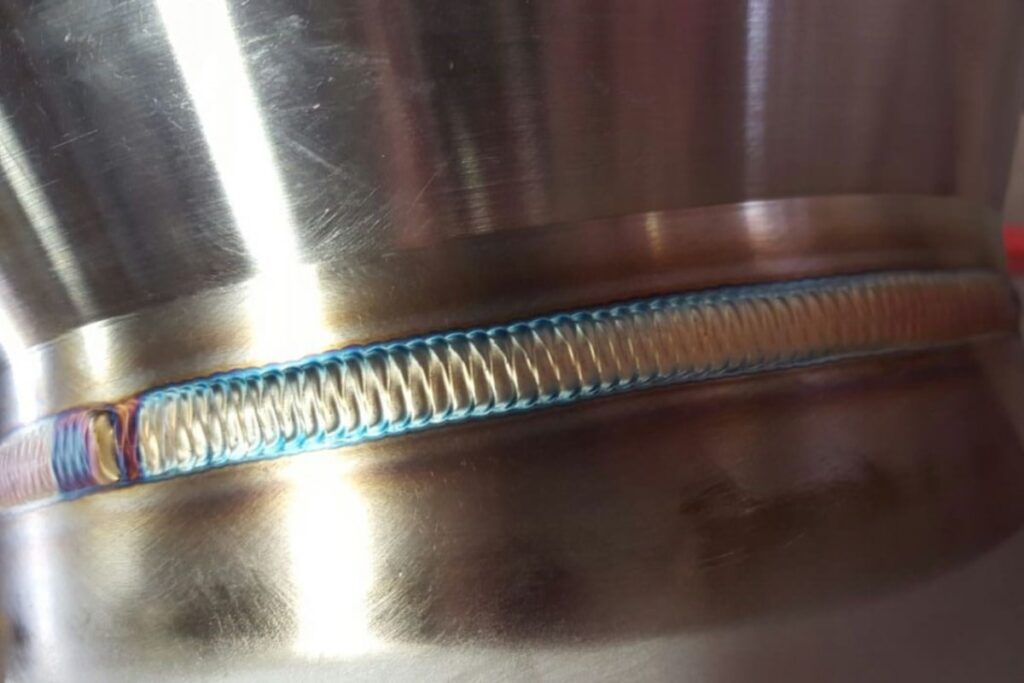There are numerous metal fabrication and metal joining processes available in the manufacturing world. Laser welding is one such method. But how exactly do laser welds work?

And how does this compare to another popular method known as tungsten inert gas (TIG) welding? Let’s look at both processes so you can decide which one is best for your project.
Let’s get started!
Laser Welding
The term “laser” refers to an electromagnetic wave with very high energy levels. This means that when light from a laser hits matter, its photons interact with electrons within the molecules, causing them to vibrate rapidly.
The rapid vibrations are called plasma waves or free-electron oscillations. Due to these free-electron bombardments, atoms become ionized and lose their nuclei.
As a result, a small portion of the material becomes highly energized and glows red hot while other areas remain cool due to a lack of interaction between plasma waves and the material itself.
When this happens, the area where the heat has been generated forms a molten pool of liquid metal. After the material hardens, the rest of the joint region is ground down until only the welded section remains.
A Common Misconception About Lasers
A common misconception about lasers is that they cause eye damage if exposed to certain wavelengths, but most modern lasers use infrared light at a wavelength of 1064nm.
Even under direct exposure, infrared light can’t reach our eyes. In fact, because the human body absorbs all visible light frequencies, any beam reaching the surface would need to be longer than 760 nm, also referred to as violet light.
At shorter lengths, like those produced by carbon dioxide lasers, the power density increases too much to produce enough heat to melt metal. A typical single pass on a laser will penetrate 1/32 inch into steel up to 0.1 inches deep.
For more information on just how powerful the average CO2 laser actually is, check out this article about CO2 Lasers Explained!
Evolution
If you’ve ever seen a movie set during WWII, chances are good that you saw a welder using a torch and a filler rod to create a spot weld.
Spot welding typically involves creating a constricted area around the perimeter of the joint through intense pressure and heat and then allowing the parts to touch lightly over the heated metal.
To make the process easier, you first want to clean the surfaces of dust or oil residue. Next, you’ll clamp the pieces in place and apply pressure by hand. Once finished, you may choose to sand off any rough edges left behind after pressing.
You should now follow the same steps again to remove the clamps and allow the spot weld to cool. It’s important not to move either piece once cooling begins; otherwise, the bond could crack or break. If necessary, you can repeat the procedure multiple times, depending on thickness requirements.
How Does Laser Welding Work?
In contrast, laser welding, also known as laser beam welding (LBW), uses a focused laser beam directed toward a target object instead of relying solely on manual force. Because of this, lasers offer greater precision control over depth, speed, quality, and consistency compared to traditional techniques.
Not surprisingly, the industry standard for laser technology today is the American National Standards Institute (ANSI). ANSI developed standards for various aspects of laser welding, including safety, equipment, procedures, software, etc. These guidelines ensure uniformity across industries.
Types of Laser Welding
Although laser welding was originally created for aircraft construction back in 1953, it didn’t gain popularity among commercial users until the 1970s. Since then, laser technology has continued to evolve and diversify. Below, we discuss some of the most commonly used applications for laser welding.
1. Diode Lasers
This type of laser emits short pulses of greenish-yellow light and is often found in electronics. Diode lasers tend to work well on thick walls of thicker objects, ranging anywhere from 2 mm to 3 mm.
2. Dye Lasers
These lasers emit long continuous beams of red or orange light. Dyes are generally cheaper, smaller, and require less maintenance than solid-state lasers and diode lasers. Dye lasers are great for thinner wall thicknesses of 4 mm or less.
3. CO2 Lasers
Also referred to as Carbon Dioxide, CO2 lasers emit long blue-colored beams ideal for cutting metals, drilling holes, and marking plastic surfaces. Although CO2 tends to cost slightly more per unit than dye lasers, it provides a wider range of working distance. Plus, it requires little postprocessing, unlike other types of lasers.
4. Excimer Lasers
Similar to CO2 lasers, excimers generate ultraviolet-colored beams suitable for marking plastics, resins, and glass. However, excimer lasers are more expensive than CO2 lasers and aren’t recommended for thicker metal joints.
5. YAG Lasers
YAG areas are particularly useful for medical devices, dental implants, optical fibers, and circuit boards. Like excimers, YAG lasers don’t cut through metals. Instead, they convert electricity directly into UV light. Another advantage is that YAG lasers operate safely at room temperature without requiring complicated chiller systems.
6. Helium-Neon Lasers
Known as HeNe, helium-neon lasers emit pink-colored beams ideal for engraving wood, stone, ceramic tile, and similar nonmetallic substrates. Also, HeNe lasers are relatively inexpensive and handy for home projects.
The Benefits of Laser Welding
There are several advantages associated with laser welding versus conventional methods.
1. High Productivity Rates
First, lasers provide faster speeds and higher productivity rates without sacrificing quality.
2. No Contamination
Second, lasers prevent contamination since no consumables are required.
3. Less Waste
Thirdly, laser welding produces less waste overall. Fourthly, lasers improve upon strength and stability by providing better structural integrity.
4. Low Labor Cost
Additionally, lasers reduce labor costs since fewer people are needed for each operation.
5. Energy Efficient
Furthermore, laser welding doesn’t burn fuel nor release toxic fumes. Lasers conserve energy because they’re able to concentrate and focus their output on specific points rather than heating entire sections evenly. Also, this technique reduces downtime since operations can run 24 hours per day.
6. Prevents Air Pollution
Lastly, laser welding prevents air pollution caused by burning fuels and oxidizers. Overall, laser welding offers significant environmental savings and improved worker safety.
TIG Welding
Unlike laser welding, TIG welding relies primarily on electric current to fuse base metals. Unlike arc welding, TIG employs argon shielding gases to protect against oxidation. Argon ions combine with oxygen to form oxides and contaminate the weld zone.
Therefore, argon gas must continuously cover the molten metal during the whole duration of the welding process. Additionally, TIG utilizes tungsten electrodes and shields the tip of the electrode with argon gas. Typically, TIG welding machines consist of three major components: gas shield, power source, and torch.
TIG Welding Procedure
Step 1
To start, the operator positions his or her feet firmly flat on a platform. Next, he or she adjusts the machine gun nozzle towards the desired workpiece. Then, the operator presses a trigger button, which activates the machine gun’s main solenoid valve.
Step 2
From here, argon gas flows into the gun via a hose connected to the primary manifold. From the manifold, the argon travels through hoses leading to the actual torch head. Inside the torch, there’s an additional tube filled with nitrogen gas.
Step 3
Here, the argon reacts with the oxygen present in the surrounding atmosphere and creates nitric oxide. Nitrogen keeps this mixture safe from being released into the air. Upon exiting the torch, the mixed argon and nitrogen gases travel through a second pipe before entering the workpiece.
Once inside the workpiece, the argon and nitrogen mix release sufficient amounts of reactive gases to shield the molten metal from ambient oxygen.
Step 4
Meanwhile, the electrical current flowing from the power source heats up the tungsten carbide tip attached to the end of the electrode. Once sufficiently hot, the tip transfers the current to the workpiece, creating sparks that help to initiate melting.
Step 5
While doing this, the operator constantly blows compressed air from the mouthpiece located near the front part of the torch head. This helps keep the molten pool clear and protects the molten metal from impurities floating in the air.
Step 6
Afterward, the operator slowly lowers the electrode along the edge of the newly formed seam. Throughout this step, the operator continues to blow compressed air intermittently to avoid the splashing of molten metal.
Step 7
Finally, the operator pulls the electrode upwards, creating a new bead. After completion, the operator removes the electrode from the workpiece and repeats the cycle until the job is done.
Note
It’s worth noting that although it looks easy, tungsten tips wear away quickly, making the life expectancy of torches quite short. Moreover, there’s always a chance of getting burned if the torch isn’t properly maintained.
On top of that, tungsten tips get extremely hot, especially when operating at maximum capacity. So, proper training and practice are essential to prevent injuries or accidents.
The Differences Between Laser and TIG Welding
Below are some important differences between laser and TIG welding:
1. Set-Up Time
The set-up time for a laser weld is longer than for TIG welding. This is due to the fact that laser welding requires a lot of time and precision to create a clean weld. On the other hand, TIG welding can be done quickly by experienced operators who know how to use their equipment.
Hence, laser welding is a more complicated process than TIG welding. Laser welding requires a lot of careful planning and execution. TIG welding can be completed in less time, but it’s not as precise as laser welding.
2. Cost
While laser welding is very costly, it’s still not as expensive as TIG welding. The initial cost of laser welding is higher because it requires a lot of equipment and training. TIG welding requires only one piece of equipment and is much less costly than laser welding.
3. Materials
Metals, steel, and many plastics can be laser welded. TIG welding is only suitable for metals and some types of ceramics.
4. Welding Equipment
Both methods require different types of equipment. Laser welding requires a laser source, a power source, a welding torch, and a power cable. TIG welding requires a power source, filler rod, electrodes, and an electrical cable.
5. Safety
TIG welding is generally considered to be more dangerous than laser welding. As a result of the radiation, electrocution, and potential fire outbreak risks associated with TIG welding, laser welding is safer to work with.
6. Skill Level Required
Laser welding requires a lot of skill and training to perform safely and successfully. The equipment is expensive, which means that there are fewer places where you can learn how to use the equipment. TIG welding, however, is easy to learn and use. It’s a good way to learn how to weld because it’s not very expensive.
7. Quality
The quality of laser welds is generally better than TIG welds due to the fact that laser welding requires much more planning and precision to complete successfully. However, do note that TIG welding produces a more consistent weld because it’s less likely to cause heat-induced damage to the surrounding materials.
8. Speed
Laser welding is faster than TIG welding. This is because TIG welding requires a higher level of detail to achieve desired results.
9. Precision
While laser welding focuses mainly on technical details involving physics, chemistry, and engineering, TIG welding emphasizes operational skills and personal experience.
With a laser, operators tend to spend more time focusing on precise positioning, alignment, and maintaining consistent settings. In contrast, with TIG welding, operators can focus on the work and get their hands dirty.
10. Process
Laser welding produces a high-powered laser beam that is focused on the joint. It cuts through the two materials while melting them into one another.
On the contrary, TIG welding uses an electric arc to heat up a filler rod and transfer it into a joint line between two materials.
The filler rod is a long piece of metal that’s fed through the TIG welding gun’s electrodes. Once the metal is melted, the filler rod is pushed into the joint, making it solid and strong.
11. Use Case
Though both methods use similar processes and equipment, laser welding tends to be more precise, while TIG welding is generally more efficient. Laser welding is a great option for industrial applications.
However, it’s not usually the first choice for home projects because of its high cost and long set-up time. TIG welding is a good choice for home projects that involve frequent or large repairs because of its low initial cost, flexible delivery schedule, and short set-up time. It also has a relatively low operating cost.
The Bottom Line
In the end, it all comes down to what you’re trying to achieve and what you want to accomplish with your welding. There are benefits and drawbacks to each method.
With laser welding, workers enjoy numerous benefits related to health and the environment.
That said, If you’re looking for an easy way to learn how to weld, TIG welding is a great option. On the other hand, if you want precision and quality in your welds, laser welding is the way to go.
Darell is a Certified Welding Engineer (CWEng) with over 23 years of expertise in TIG, MIG, MAG, dual flux, and stick welding. He is a senior welding engineer who has a desire to share his experience. Visit unwelded.com and join Darell as well as other welding enthusiasts in obtaining fabrication knowledge, amazing welding gadgets, and useful welding insights.



